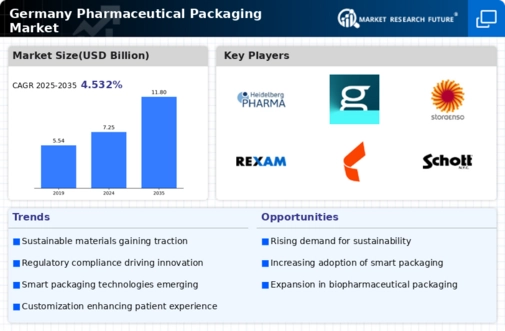Rising Demand for Biologics
The increasing prevalence of chronic diseases in Germany is driving the demand for biologics, which require specialized packaging solutions. The pharmaceutical packaging market is adapting to this trend by developing advanced materials that ensure the stability and efficacy of biologics. In 2025, the market for biologics is projected to reach approximately €30 billion, indicating a robust growth trajectory. This surge necessitates innovative packaging that can maintain the integrity of sensitive biologic products during storage and transportation. As a result, manufacturers are investing in smart packaging technologies that provide real-time monitoring of temperature and humidity, thereby enhancing product safety and compliance. The pharmaceutical packaging market is thus evolving to meet the specific needs of biologics, ensuring that these critical therapies are delivered effectively to patients.
Evolving Regulatory Landscape
The regulatory landscape governing the pharmaceutical packaging market in Germany is continuously evolving, necessitating that companies remain agile and compliant. Recent updates to packaging regulations emphasize the importance of clear labeling, child safety, and tamper evidence. In 2025, compliance with these regulations is expected to drive a 10% increase in demand for specialized packaging solutions that meet stringent standards. Companies are investing in research and development to ensure that their packaging not only complies with current regulations but also anticipates future changes. This proactive approach is essential for maintaining market access and avoiding costly penalties. As such, the pharmaceutical packaging market is characterized by a dynamic interplay between regulatory compliance and innovation, compelling manufacturers to adapt swiftly to maintain their competitive edge.
Increased Focus on Patient Safety
Patient safety remains a paramount concern within the pharmaceutical packaging market, particularly in Germany. The rise in medication errors has prompted regulatory bodies to enforce stricter guidelines on packaging design and labeling. In 2025, it is estimated that the market for safety-oriented packaging solutions will grow by 15%, reflecting the industry's commitment to reducing risks associated with medication administration. Features such as child-resistant closures, tamper-evident seals, and clear labeling are becoming standard in the packaging of pharmaceuticals. This focus on safety not only protects patients but also enhances the overall credibility of pharmaceutical brands. Consequently, the pharmaceutical packaging market is witnessing a shift towards designs that prioritize user-friendliness and safety, thereby fostering greater trust among consumers and healthcare professionals alike.
Sustainability and Eco-Friendly Packaging
Sustainability is emerging as a critical driver in the pharmaceutical packaging market, particularly in Germany, where environmental regulations are becoming increasingly stringent. The demand for eco-friendly packaging solutions is on the rise, with a projected growth of 18% in the market for sustainable materials by 2025. This shift is prompting manufacturers to explore biodegradable and recyclable materials that minimize environmental impact. Companies are also focusing on reducing packaging waste through innovative designs that use less material without compromising product safety. As consumers become more environmentally conscious, the pharmaceutical packaging market is responding by prioritizing sustainability in its offerings, thereby aligning with broader societal goals of reducing carbon footprints and promoting responsible consumption.
Technological Integration in Packaging Solutions
The integration of advanced technologies into packaging solutions is transforming the pharmaceutical packaging market in Germany. Innovations such as RFID tracking, QR codes, and smart labels are being increasingly adopted to enhance supply chain transparency and product traceability. In 2025, the market for smart packaging is expected to grow by 20%, driven by the need for real-time data on product conditions. These technologies not only improve inventory management but also provide valuable information to consumers regarding product authenticity and usage instructions. As a result, pharmaceutical companies are investing in these technologies to streamline operations and improve customer engagement. The pharmaceutical packaging market is thus becoming more sophisticated, leveraging technology to meet the evolving demands of both manufacturers and consumers.






















Leave a Comment